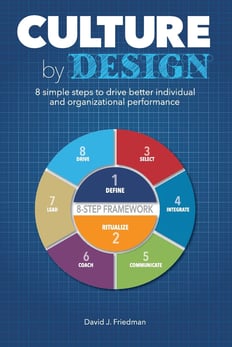 In our last blog, Define Employee Behavior to Build Your Culture, we shared how driving culture is a teaching function. It’s not simply posting your vision and mission. You and your leadership team teach your people day after day after day, not by what you say, but how you act.
In our last blog, Define Employee Behavior to Build Your Culture, we shared how driving culture is a teaching function. It’s not simply posting your vision and mission. You and your leadership team teach your people day after day after day, not by what you say, but how you act.
Absent an intentional force on your part, your company culture is created, mostly influenced by those with the strongest personalities.
In Culture by Design: How to Build a High-Performing Culture, Even in the New Remote Work Environment David Friedman calls his system an “operating system” for culture. It’s intended to get culture so deeply ingrained in the of the organization you can see it in every member of your team. It becomes their DNA. Your culture is pervasive in a way it’s not dependent on just one person.
Here are Friedman’s 8 step system:
Step 1: DEFINE the employee behaviors (Freidman calls these Fundamentals) that drive your success
To create and drive your culture you must describe it with clarity. What exactly do you want your culture to be. Few organizations can say what their culture is.
If you don’t know what you’re teaching, because you’ve not defined it clearly, you’re not to be able to do it effectively, and certainly not consistently.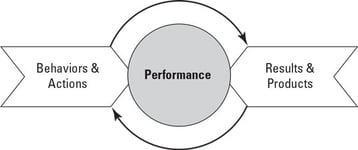
If driving culture is mostly a teaching function, then define exactly what you want your people to learn and build a curriculum around it. You’ll ensure everyone learns the same thing, ultimately, you’ll see greater organizational consistency.
Define our culture in absolute terms. Then build a curriculum around it so everyone teaches and learns the same thing.
Step 2: RITUALIZE the practice of your Fundamentals
Creating “rituals” is one of the simplest, and yet most powerful, concepts. It’s the key to making things last.
Many new programs or initiatives have started at work and in our personal lives, only to see them fall by the wayside as we got busy with “real life”? These failures lead to 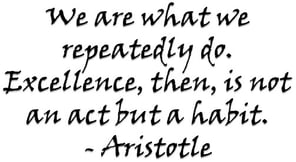 cynicism in our workforce. Your people see every new initiative as the “flavor of the month.” They refuse to engage because they know it will soon be forgotten and/or replaced with a different initiative.
cynicism in our workforce. Your people see every new initiative as the “flavor of the month.” They refuse to engage because they know it will soon be forgotten and/or replaced with a different initiative.
Rituals enable us to stick with things when we wouldn’t normally have the discipline or the motivation to do so on our own.
Step 3: SELECT people who are the right fit for your culture
To build a truly high-performing culture, choose people fit for your culture. People are who they are.
 Start with people who fit in your culture. Taking people who aren’t a good fit hoping you can transform them, reduces the probability of success. We recommend Topgrading.
Start with people who fit in your culture. Taking people who aren’t a good fit hoping you can transform them, reduces the probability of success. We recommend Topgrading.
Step 4: INTEGRATE new hires into your culture
Freidman calls the process “orientation” or “on-boarding,” Integration. It’s the process get your new hires up and running in our organization.
“Integration” provides a different connotation than “orientation.” Orientation suggests you tell them about you. You orient them to you. Integration implies your new team member becomes one of us.
A person’s first week on the job is the most important week in their entire career. It’s that impactful.
 The first week sets the tone for everything to follow. It’s the new person’s first impression, and those early impressions tend to be lasting and difficult to change. Few companies spend appropriate time and resources orchestrating every aspect of a new hire’s early experience. Companies spend huge amounts of time, energy, and money on recruiting. Few provide detailed attention on how the new person starts.
The first week sets the tone for everything to follow. It’s the new person’s first impression, and those early impressions tend to be lasting and difficult to change. Few companies spend appropriate time and resources orchestrating every aspect of a new hire’s early experience. Companies spend huge amounts of time, energy, and money on recruiting. Few provide detailed attention on how the new person starts.
Step 5: COMMUNICATE your culture throughout the organization
The more people see and hear about your culture, the more they think about it, the more it becomes part of their everyday experience. Visible reminders are important.
Many companies post inspirational quotes or images on their walls. Unfortunately, these are not their real culture. When your culture is authentic, the more images and reminders of it, the better.
Step 6: COACH to reinforce your culture
Your culture is the actual behavior of your people. The best way to know your culture is to observe your people and how they operate.
Friedman notes, “How your leaders provide their teams with coaching and guidance on how to resolve issues, as well as feedback on what was done, are critical opportunities to teach and reinforce your culture. Every time you use the specific language and vocabulary of your culture in a coaching session, you remove culture from your walls and make it relevant and meaningful. You show your words on the wall are real, rather than just being signage.”
Step 7: LEAD your culture by example
What YOU do speaks more loudly than what YOU say. Your people constantly looking at you, consciously and unconsciously. They take their cues from YOU about what’s important. How you handle a difficult customer call, or a thorny ethical question tells them how you respect your culture.
People learn from you every single day. They learn from what you do and from what you don’t do.
S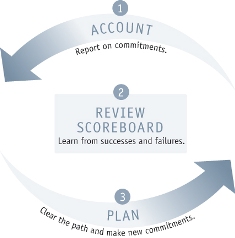 tep 8: DRIVE your culture through accountability
tep 8: DRIVE your culture through accountability
Be accountable specifically for your culture. How do you show your people and the world you’re serious about this? If there’s no accountability for it, it’s just a wish. See the blogs on Propeller and Accelerate Change by Getting Accountability Right.
There are many ways to show your seriousness. Annual surveys on your performance in living to your culture, include elements of your culture in your performance reviews, to replace people who aren’t a fit for our culture.
To create an environment where everyone is inspired to give their best, contact Positioning Systems today to schedule a free exploratory meeting.
Growth demands Strategic Discipline.
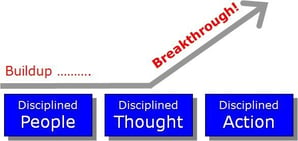 Building an enduring great organization requires disciplined people, disciplined thought, disciplined action, superior results, producing a distinctive impact in the world.
Building an enduring great organization requires disciplined people, disciplined thought, disciplined action, superior results, producing a distinctive impact in the world.
Discipline sustains momentum, over a long period of time, laying the foundations for lasting endurance.
A winning habit starts with 3 Strategic Disciplines: Priority, Metrics, and Meeting Rhythms. -2.jpg?width=306&name=3%20Disciplines%20of%20Execution%20(Strategic%20Discipline)-2.jpg) Forecasting, accountability, individual, and team performance improve dramatically.
Forecasting, accountability, individual, and team performance improve dramatically.
Meeting Rhythms achieve a disciplined focus on performance metrics to drive growth.
Let Positioning Systems help your business achieve these outcomes on the Four most Important Decisions your business faces:
|
DECISION |
RESULT/OUTCOME |
|
PEOPLE |
|
|
STRATEGY |
|
|
EXECUTION |
|
|
CASH |
|
Positioning Systems helps mid-sized ($5M - $500M) business Scale-UP. We align your business to focus on Your One Thing! Contact dwick@positioningsystems.com to Scale Up your business! Take our Four Decisions Needs Assessment to discover how your business measures against other Scaled Up companies. We’ll contact you.
 NEXT BLOG – Copywriting Tricks for Entrepreneurs Who Hate Writing
NEXT BLOG – Copywriting Tricks for Entrepreneurs Who Hate Writing
I’m taking the final week of the year off and will be having guest writer Frank Hamilton deliver the message for next week’s blog. If you believe you should be writing and hate it, be sure to catch Frank’s message to help you write!






.jpeg?width=150&height=135&name=Hand%20with%20marker%20writing%20the%20question%20Whats%20Next_%20(1).jpeg)

